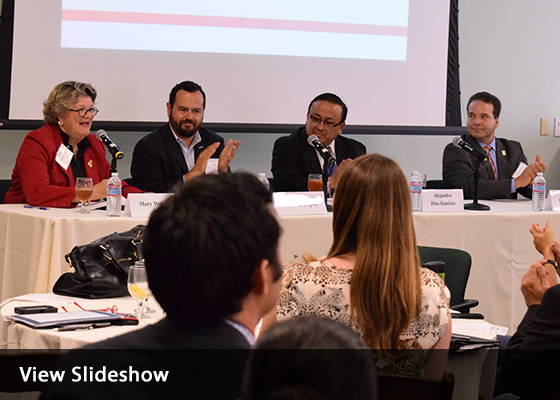
Binational leaders converge at USMEX for Global Diaspora Week
| By Anthony King, GPS News
The Center for U.S.-Mexican Studies (USMEX) at UC San Diego played host to an official stop on the International Diaspora Engagement Alliance’s diaspora tour Monday, Oct. 13. The Alliance held 65 events across the world dedicated to diaspora communities and their contributions to global development for Global Diaspora Week, Oct. 12 – 18.
UC San Diego’s Symposium on the Mexican Diaspora in San Diego was implemented by the U.S. Department of State and Mexico’s Institute for Mexicans Abroad (IME). UC San Diego Chancellor Pradeep Khosla gave the afternoon’s welcome remarks after introductions by School of International Relations and Pacific Studies acting Dean Gordon Hanson.
“At UC San Diego we have a commitment to the Mexican diaspora in this region,” Khosla said to the packed room of more than 100 attendees. “If you look at the entire country, the only top-10 university located in the border region of Mexico is UC San Diego. We want to build closer ties with Mexico, and we want to build more exchanges.”
Representatives from the University of California’s recently announced UC-Mexico Initiative were in attendance, including guest speaker and UC-Mexico Initiative Assistant Director Alberto Diaz of the Office of the President. The initiative is housed at UC Riverside.
“As you know, this initiative was launched with the objective of expanding the connection with Mexico and developing a sustained and equal partnership. We hope this event will be the first of many to come,” Diaz said, reiterated by USMEX Associate Director Melissa Floca.
Benefitting from the global diaspora
There are over 12 million first-generation Mexicans living abroad, with 99 percent based in the United States. Of those, 38 percent live in California. Ten percent of the entire U.S. population are Hispanics of Mexican origin, totaling 33.7 million.
IME Director Ernesto De Lucas explained these and other key statistics of the Mexican diaspora community, saying the goal of the IME is to promote the integration of Mexicans in their destination countries while also linking them to their communities of origin.
In San Diego County, there are close to 900,000 people of Mexican origin, 300,000 of which were born in Mexico. The largest diaspora population comes from Baja California, followed by the states of Oaxaca, Michoacan and Guerrero. The country’s capital, Mexico City, rounds out the top five origin locations, said Mexico’s consul general in San Diego, Remedios Gomez Arnau.
“This is a very good place to start the tour of the Mexican diaspora, a diaspora that has been contributing to the betterment of the economies and the societies of Mexico and the United States,” she said. “We need to recognize that.”
Gomez Arnau’s U.S. counterpart in Tijuana, U.S. Consul General Andrew Erikson, was integral in bringing the tour to UC San Diego, and said the U.S. has the largest number of global diaspora members of any country in the world with over 40 million people. He called the U.S. the “world capital” of the global diaspora the “biggest beneficiary” of diaspora communities through continued economic growth, human capital and development.
“Latinos in the United States continue to open businesses at twice the national rate, and immigrants are 30 percent more likely to form new businesses than U.S.-born citizens,” Erikson said. “These businesses create jobs. That’s the magic of the diaspora.”
He said the Department of State recognizes the value of the diaspora community to both countries, particularly at border regions like San Diego-Tijuana. Several programs to promote these communities — from the Small Business Network of the Americas and the International Sister Center partnership to 100,000 Strong in the Americas, a program promoting study-abroad exchanges for students — have been developed.
“More than 60 million Americans are first or second generation descendants of immigrants,” Erikson said. “It’s a story as old as America itself.”
Southern California as a key location
The San Diego tour stop included two panel discussions. Moderated by UC San Diego Extension Dean Mary Walshok, the first was a roundtable on the dynamics of the region’s binational economy and the role of the Mexican diaspora in converting the border into an engine of growth.
The second panel brought together researchers from UC San Diego, UCLA and the nonprofit Frente Indigena Oaxaqueno Binacional to discuss the Oaxacan diaspora in Southern California. San Diego has the largest population of Mexican nationals from the state of Oaxaca, followed by Los Angeles. Wayne Cornelius, UC San Diego professor emeritus and founding director of USMEX, moderated.
In closing, USMEX Senior Policy Advisor Denise Ducheny thanked participants and summarized key points. Ducheny, a former state senator and assembly member, was recently chosen by President Barack Obama to serve on the board of the Border Environment Cooperation Commission and the North American Development Bank.
“Denise is a vibrant member of our UC San Diego community, and she has a big impact on how we think about U.S.-Mexico relations and what is important to our two countries,” Khosla said.
Sponsors for the San Diego diaspora tour stop included USMEX, the Institute of the Americas, Scholars Strategy Network and the Center for Comparative Immigration Studies.
